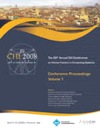CHI 2008: a selection on social applications
(Papers are linked to their pdf downloads, if available.)
Ambient social tv: drawing people into a shared experience [abstract]
Authors: Gunnar Harboe, Crysta J. Metcalf, Frank Bentley, Joe Tullio, Noel Massey and Guy Romano (Motorola Labs)
Abstract: We examine how ambient displays can augment social television. Social TV 2 is an interactive television solution that incorporates two ambient displays to convey to participants an aggregate view of their friends’ current TV-watching status. Social TV 2 also allows users to see which television shows friends and family are watching and send lightweight messages from within the TV-viewing experience. Through a two-week field study we found the ambient displays to be an integral part of the experience. We present the results of our field study with a discussion of the implications for future social systems in the home.
Results from deploying a participation incentive mechanism within the enterprise [abstract]
Authors: Rosta Farzan (University of Pittsburgh), Joan M. DiMicco (IBM, Cambridge), David R. Millen (IBM, Cambridge), Casey Dugan (IBM, Cambridge), Werner Geyer (IBM, Cambridge) and Elizabeth A. Brownholtz (IBM, Cambridge)
Abstract: Success and sustainability of social networking sites is highly dependent on user participation. To encourage contribution to an opt-in social networking site designed for employees, we have designed and implemented a feature that rewards contribution with points. In our evaluation of the impact of the system, we found that employees are initially motivated to add more content to the site. This paper presents the analysis and design of the point system, the results of our experiment, and our insights regarding future directions derived from our post-experiment user interviews.
Exploring the role of the reader in the activity of blogging [abstract]
Authors: Eric Baumer, Mark Sueyoshi and Bill Tomlinson (UC Irvine)
Abstract: Within the last decade, blogs have become an important element of popular culture, mass media, and the daily lives of countless Internet users. Despite the medium’s interactive nature, most research on blogs focuses on either the blog itself or the blogger, rarely if at all focusing on the reader’s impact. In order to gain a better understanding of the social practice of blogging, we must take into account the role, contributions, and significance of the reader. This paper presents the findings of a qualitative study of blog readers, including common blog reading practices, some of the dimensions along which reading practices vary, relationships between identity presentation and perception, the interpretation of temporality, and the ways in which readers feel that they are a part of the blogs they read. It also describes similarities to, and discrepancies with, previous work, and suggests a number of directions and implications for future work on blogging.
The network in the garden: an empirical analysis of social media in rural life [abstract]
Authors: Eric Gilbert, Karrie Karahalios and Christian Sandvig (University of Illinois at Urbana-Champaign)
Abstract: History repeatedly demonstrates that rural communities have unique technological needs. Yet, we know little about how rural communities use modern technologies, so we lack knowledge on how to design for them. To address this gap, our empirical paper investigates behavioral differences between more than 3,000 rural and urban social media users. Using a dataset collected from a broadly popular social network site, we analyze users’ profiles, 340,000 online friendships and 200,000 interpersonal messages. Using social capital theory, we predict differences between rural and urban users and find strong evidence supporting our hypotheses. Namely, rural people articulate far fewer friends online, and those friends live much closer to home. Our results also indicate that the groups have substantially different gender distributions and use privacy features differently. We conclude by discussing design implications drawn from our findings; most importantly, designers should reconsider the binary friend-or-not model to allow for incremental trust-building.
Healthcare in everyday life: designing healthcare services for daily life [abstract]
Authors: Stinne Aaløkke Ballegaard, Thomas Riisgaard Hansen and Morten Kyng (University of Aarhus)
Abstract: Today the design of most healthcare technology is driven by the considerations of healthcare professionals and technology companies. This has several benefits, but we argue that there is a need for a supplementary design approach on the basis the citizen and his or her everyday life. An approach where the main focus is to develop healthcare technology that fits the routines of daily life and thus allows the citizens to continue with the activities they like and have grown used to — also with an aging body or when managing a chronic condition. Thus, with this approach it is not just a matter of fixing a health condition, more importantly is the matter of sustaining everyday life as a whole. This argument is a result from our work — using participatory design methods — on the development of supportive healthcare technology for elderly people and for diabetic, pregnant women.
International ethnographic observation of social networking sites [abstract]
Authors: Christopher N. Chapman (Microsoft Corporation) and Michal Lahav (Sakson & Taylor Consulting)
Abstract: Current research on social networking largely covers US providers. To investigate broader trends, we examine cross-cultural differences in the usage patterns of social networking services with observation and ethnographic interviews in multiple cultures. This appears to be the first systematic investigation of social networking behavior across multiple cultures. We report here on the first four locations with observation and interviews of 36 respondents, 8-10 in each of the US, France, China, and South Korea. The results show three dimensions of cultural difference for typical social networking behaviors: the users’ goals, typical pattern of self expression, and common interaction behaviors. These differences exemplify a developmental path of interest in social networking and the gradual integration of social networking behavior into more general communications behaviors. Future work in other cultures and with additional methods will evaluate the hypotheses presented here.




